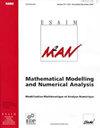Convergence Analysis of Pressure Reconstruction Methods from discrete velocities
IF 1.9
3区 数学
Q2 Mathematics
Esaim-Mathematical Modelling and Numerical Analysis-Modelisation Mathematique et Analyse Numerique
Pub Date : 2023-03-20
DOI:10.1051/m2an/2023021
引用次数: 2
Abstract
Magnetic Resonance Imaging allows the measurement of the three-dimensional velocity field in blood flows. Therefore, several methods have been proposed to reconstruct the pressure field from such measurements using the incompressible Navier-Stokes equations, thereby avoiding the use of invasive technologies . However, those measurements are obtained at limited spatial resolution given by the voxel sizes in the image. In this paper, we propose a strategy for the convergence analysis of state- of-the-art pressure reconstruction methods. The methods analyzed are the so-called Pressure Poisson Estimator (PPE) and Stokes Estimator (STE). In both methods, the right-hand side corresponds to the terms that involving the field velocity in the Navier-Stokes equations, with a piecewise linear interpolation of the exact velocity. In the theoretical error analysis, we show that many terms of different order of convergence appear. These are certainly dominated by the lowest-order term, which in most cases stems from the interpolation of the velocity field . However, the numerical results in academic examples indicate that only the PPE may profit of increasing the polynomial order, and that the STE presents a higher accuracy than the PPE, but the interpolation order of the velocity field always prevails . Furthermore, we compare the pressure estimation methods on real MRI data, assessing the impact of different spatial resolutions and polynomial degrees on each method. Here, the results are consistent with the academic test cases in terms of sensitivity to polynomial order as well as the STE showing to be potentially more accurate when compared to reference pressure measurements.离散速度压力重构方法的收敛性分析
磁共振成像可以测量血流中的三维速度场。因此,已经提出了几种方法,利用不可压缩的Navier-Stokes方程从这些测量中重建压力场,从而避免使用侵入性技术。然而,这些测量是在由图像中的体素大小给出的有限空间分辨率下获得的。在本文中,我们提出了一种策略来收敛分析最先进的压力重建方法。所分析的方法是压力泊松估计法(PPE)和斯托克斯估计法(STE)。在这两种方法中,右手边对应于纳维-斯托克斯方程中涉及场速度的项,并对精确速度进行分段线性插值。在理论误差分析中,我们发现出现了许多不同收敛阶的项。这些当然是由最低阶项主导的,在大多数情况下,它源于速度场的插值。然而,学术算例的数值结果表明,只有PPE有利于提高多项式阶数,STE比PPE具有更高的精度,但速度场的插值阶数总是占优的。此外,我们比较了真实MRI数据上的压力估计方法,评估了不同空间分辨率和多项式度对每种方法的影响。在对多项式阶的敏感性方面,结果与学术测试案例一致,并且与参考压力测量相比,STE显示可能更准确。
本文章由计算机程序翻译,如有差异,请以英文原文为准。
求助全文
约1分钟内获得全文
求助全文
来源期刊

CiteScore
2.70
自引率
5.30%
发文量
27
审稿时长
6-12 weeks
期刊介绍:
M2AN publishes original research papers of high scientific quality in two areas: Mathematical Modelling, and Numerical Analysis. Mathematical Modelling comprises the development and study of a mathematical formulation of a problem. Numerical Analysis comprises the formulation and study of a numerical approximation or solution approach to a mathematically formulated problem.
Papers should be of interest to researchers and practitioners that value both rigorous theoretical analysis and solid evidence of computational relevance.
 求助内容:
求助内容: 应助结果提醒方式:
应助结果提醒方式:


